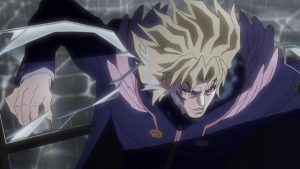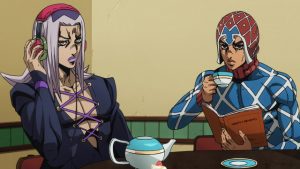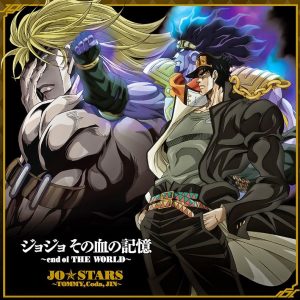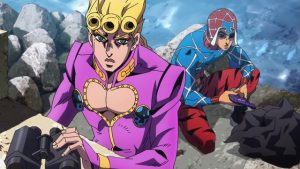
For the last 6 years, dedicated fans to Hirohiko Araki’s JoJo series have finally gotten an anime that truly represents it. Not only do manga fans get a kick out of it, the anime has assisted in getting more international fans interested in the franchise as well. However, prior to the debut of the present series that premiered in 2012, JoJo had a very bizarre and difficult history of getting the anime it truly deserved. So, how do they compare? Read this edition to Then Vs. Now to find out!
Phantom Blood
As some of you may know, Phantom Blood is the first story arc to the original JoJo manga. Just five years before the debut of the TV series, Phantom Blood premiered as a movie animated by APPP studios, who did OVAs to Stardust Crusaders in 1993 and 2000. This movie was heavily panned by critics, fans and even by Araki himself! What largely gave it so much hate is that Speedwagon, a popular character from the manga and a (supposed) favorite of Araki’s, is entirely cut from the movie! Also, Wang Chun, one of Dio’s assistants during that arc, is also cut. Due to the inexcusable cuts from this movie and to the point of Araki also denouncing it, this movie has NEVER gotten any kind of home video release. The closest you can get is a 15-minute non-audio video on YouTube.
As for the 2012 series, you’re getting the whole story arc and a bag of chips with a diet soda. You can thank Araki for being heavily involved since he wanted it to be as faithful to his work as much as possible.
Stardust Crusaders
The first JoJo anime debuted as an OVA back in 1993, which covered a small portion of the last act of Stardust Crusaders. As crazy as this sounds, the first episode of the 1993 OVA is when the cast first meets Iggy and has to fight N’Doul! If you’re familiar with the newer TV series, this episode kicks off the second half of the Stardust Crusaders TV series! In order to follow the older OVA upon its release, it was imperative for you to have read the manga in order to understand what’s going on! APPP didn’t get around to animating the beginning of the series for at least another 8 years! Even when they animated a story on how the band gets together, the OVA cuts out so much! You don’t get Oingo Boingo, Pet Shop and D’Arby’s brother since they are ultimately cut. To sum it up, the OVA is style over substance and serves more as an advertisement for the manga. However, the brutality and excitement of the action is still present which is how it still managed to get any praise.
Beyond content and characters being cut in the OVA, the tone feels so much different. Just about any comedic elements of the OVA (other than the plot twist of Jotaro’s hand when he played poker against D’Arby, or Iggy farting on Polnareff) are not at all present as well, most especially Grandpa Joseph’s uses of English explicits in the Japanese version. The OVA is pretty much serious in tone to suit the violent aspects of JoJo
Use of Colors
For the newer anime, if there’s one thing it’s reputable for, it’s for its vibrant use of high-res colors that masterfully compliment the covers you see in the original manga. As we have previously shared in other JoJo related articles, this anime is the ultimate psychedelic experience (without having to take any). It adds more tension and excitement to the atmosphere, and just helps the series live up to its name. Plus, that quality excellently pays homage to how the franchise takes influence from the era of sex, drugs, and rock ‘n’ roll. The OVA’s use of colors is pretty much standard and is largely grainy and dark in tone. It suits the respective atmosphere that OVA gives by emphasizing more on the violent spectacles, but nothing else.
Music
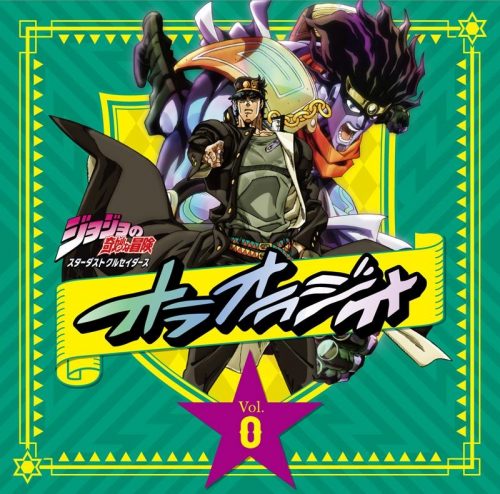
Music plays a large influence into the world of JoJo with the names of characters and stands, so it is imperative in terms of soundtrack, an anime to JoJo should live up to that. As for the OVAs, it does have a soundtrack that suits its respective series, but you don’t get anything in your face and memorable. This is where the TV series runs loops around it. The soundtrack to the TV series is loud and proud, and knows how to capture all of the elements JoJo is famous for with its heavy guitars. As for the OVA, its respective soundtrack works but by no means memorable.
Lastly, fans love how the TV series uses actual famous songs throughout the history of pop culture as ending themes. It made Roundabout by Yes a unique meme and is meant to be a throwback to how Araki listened to this song when he started the manga. And who would have thought that other 80s and 90s hits like Walk Like An Egyptian by The Bangles or I Want You by Savage Garden would become an ending theme to this hit anime? It may come across weird as first, but you see how these songs are implemented with the imagery and how their tones and rhythm excellently go hand-in-hand.
Final Thoughts
There will always be a place for the original OVA to Stardust Crusaders, but the 2012 series is the anime dedicated fans were long overdue. If you enjoy insane violence and anarchy, the OVA gets the job done in those regards. As for the newer series, you don’t need any exposure prior to the manga to enjoy it but when watching the ending credits, it has many foreshadowing elements that long-time readers do appreciate. When it’s all said and done, thanks to Araki’s direct involvement, the newer anime is the true representation of JoJo.


